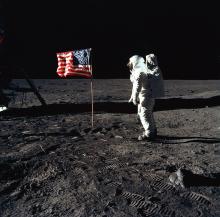Listen to today's episode of StarDate on the web the same day it airs in high-quality streaming audio without any extra ads or announcements. Choose a $8 one-month pass, or listen every day for a year for just $30.
You are here
Space
“Outer space” is one of those things you know when you see it. The sky is dark and quiet, with no air to sustain life. But just where space begins is hard to say — there’s no single definition that’s accepted by one and all.
In the last century, the National Advisory Committee for Aeronautics — the forerunner to NASA — said that space begins 50 miles up. At that altitude, the air pressure is only about a hundred-thousandth of the pressure at sea level. NASA and the Air Force have used that definition to award astronaut wings, beginning with the pilots of the X-15 rocketship in the 1960s.
Later, Engineer Theodore von Karman devised a slightly higher altitude for where space begins: 100 kilometers — about 62 miles. At that altitude, the air pressure is just one-millionth of the pressure at sea level. In such thin air, a craft must move at orbital velocity to stay aloft.
That altitude became known as the Karman Line, and today it’s the most commonly used definition for the edge of space. Anything that stays below the line is an aircraft, while anything that goes above it is a spacecraft. More than 500 people have flown above the line, qualifying them as space travelers.
A few wisps of atmosphere extend far above the Karman Line — up to several thousand miles. The air is so thin, though, that it’s basically a vacuum — a region that, for most of us, would certainly qualify as “outer space.”
We’ll talk about why space is dark tomorrow.
Script by Damond Benningfield






